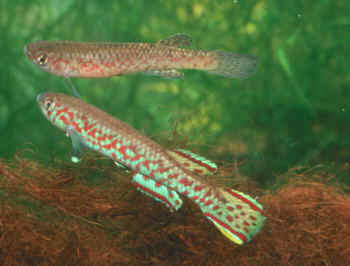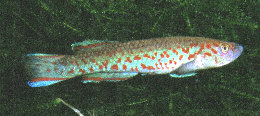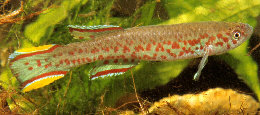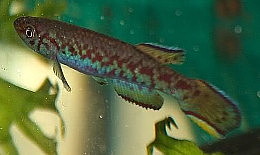Scriptaphyosemion chaytori (Roloff 1971)

Pair
imported into the USA in 1977. Distributed as Red chaytori.
Photo courtesy of Tony Terceira,
| Meaning of Name |
After Prof. Dr. Daniel Chaytor, an African ichthyologist who assisted Roloff in the study & collection of the sp. | ||||||
| First Description |
Roloff E. 1971. Roloffia chaytori spec. nov. Beschreibung einer neuen Roloffia - Art aus Sierra Leone. Die Aquarien und Terrarien Zeitschrift (DATZ), 26 (6): pages 182-184 with 2 figures. | ||||||
| Size |
5.5 cm | ||||||
| Meristics |
D = 11-12, A = 15-16, D/A= +6, ll = 32-34 (Roloff 1971). | ||||||
| Karyotype |
n = 21 (Scheel 1974) | ||||||
| Sub-Genus |
| ||||||
| Group |
S.liberiensis | ||||||
| Synonyms |
| ||||||
Populations
|
Bo - Collected by Roloff around 1971. Fulawahun - Collected by Busch & Wiese in 1993 (SL 93 code). Kaiama - Collected by Roloff around 1971. Kamabai - Collected by Busch & Wiese in 1993 (SL 93 code). Kasewe
- Various collections also from this area shown as Kasewe Forest or Kasewe Hills.
Roloff collected them in the Kasewe area around 1971. Ngabu - Collected by Roloff around 1971. Njala - Collected by Roloff around 1971. Nom Lempeh - Also spelt 'Num'. Collected by Busch & Wiese in 1993 (SL 93 code). Nom Mussiray - Collected by Busch & Wiese in 1993 (SL 93 code). Pujehun - Collected by Roloff around 1971. Rokupr (Type locality) - Collected by Roloff in 1971. This link takes you to the Roloffia home page which contains photograph's of various populations http://home10.inet.tele.dk/kdinesen/gallery/gallery.html | ||||||
| Type Locality |
A stream flowing from the Rokupr pumping station in western Sierra Leone. | ||||||
| Distribution |
Scriptaphyosemion roloffi is found in nearby water holes which may be connected during the rainy season. This sp. reportedly spawns 'on the bed' of streams whereas S.chaytori spawns in surface plant. Distributed in the Sewa, Little Scaries, Great Scaries & Taia River drainage systems. | ||||||
| Habitat |
Found in small brooks & streams which are high in oxygen content. These streams flow into deep shade from jungle trees. S.chaytori is found in shaded parts of the water course along with E.barmoiensis & other Epiplatys sp. S.chaytori avoids open waters & higher temperatures. Water chemistry has been measured at pH 6 - 7, DH 1 - 7 with a water temperature of 73 -77'F. The Rokupr location measured 23 - 24'C water temperature at mid-day, DH 0.64, pH 6.3, air temperature at mid-day 35'C. Roloff returned to this location in April 1969 but failed to find the above killifish sp. probably due to the presence of predatory cichlids (Hemichromis sp.). | ||||||
| Distinguishing Characteristics |
Perhaps the best method of seperating this sp. is through the females which have numerous spots on their sides. This particular marking is unique to this sp.as other forms previously known under Roloffia have either none or a greater degree of marking. Females collected at Rokupr have less spots which are smaller. Males have a basic pale blue body colouration with heavy red markings on un-paired fins. Outer margins of un-paired fins are also pale blue. | ||||||
| Colour/Pattern Variability | Males of the Kasewe population have an intense blue colouration. | ||||||
| History |
First discovered by E.Roloff at the discharge of the Rokupr pumping station in Sierra Leone. Clausen was first to describe this form but could not do so due to contracting a disabling disease while working in West Africa. Dr. Max Poll of the Congo Museum in Belgium was later asked to identify them & did so as R.liberiense. Roloff was not convinced they were this sp. & took photographs of female R.liberiense from the British Museum (Natural History) & compared these with material collected from Rokupr. The difference showed they were undoubtedly two different sp. Roloff described them as Roloffia chaytori in 1971. Roloff caught them on collecting trips in 1965, 1968 & 1969 at Kasewe, Taiama, Njala & Pujebun. | ||||||
| Breeding Notes |
Reports suggest that this sp. is a top spawner which prefers to lay eggs in floating vegetation or surface mops. Breeding tanks should be shaded. Eggs incubate in water for 12 days up to 3 weeks. Fry are able to consume newly hatched brine shrimp. Young fish have been observed with the parents. Spawning has been observed when the young fish are 6-7 months old. They have been recorded to spawn up to the age of two and a half years. High temperatures reportedly shorten the life of this sp. | ||||||
| Diameter of Egg | 1.1 mm | ||||||
| Remarks |
S.chaytori & S.roloffi have, in the past, been called one & the same species although they are reportedly found in the same general area they have not been caught together. This is a very colourful member of the genus which unfortunately is rarely seen in the hobby (2000). The BKA seperatum is well worth looking at for more information. An article appeared in 'The Aquarium' December 1970 pp. 9-12 & 46. entitled "Roloffia Species Under Wrong Flags". |




